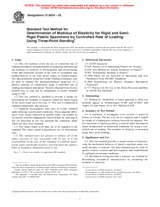Potrebujeme váš súhlas na využitie jednotlivých dát, aby sa vám okrem iného mohli ukazovať informácie týkajúce sa vašich záujmov. Súhlas udelíte kliknutím na tlačidlo „OK“.
ASTM D5934-02
Standard Test Method for Determination of Modulus of Elasticity for Rigid and Semi-Rigid Plastic Specimens by Controlled Rate of Loading Using Three-Point Bending (Withdrawn 2009)
Automaticky preložený názov:
Štandardná skúšobná metóda pre stanovenie modulu pružnosti pre pevné a polotuhého plastu vzoriek riadenú rýchlosť nakládky Použitie trojbodového Ohýbanie ( Withdrawn 2009 )
NORMA vydaná dňa 10.4.2002
Informácie o norme:
Označenie normy: ASTM D5934-02
Poznámka: NEPLATNÁ
Dátum vydania normy: 10.4.2002
Kód tovaru: NS-33128
Počet strán: 4
Približná hmotnosť: 12 g (0.03 libier)
Krajina: Americká technická norma
Kategória: Technické normy ASTM
Anotácia textu normy ASTM D5934-02 :
Keywords:
elasticity, modulus, plastics, rigid, plastics, semi-rigid, three-point bending, ICS Number Code 83.040.01 (Raw materials for rubber and plastics in general)
Doplňujúce informácie
| Significance and Use | ||||||||||||
|
This test method provides a simple means of characterizing the mechanical behavior of plastics materials using very small amounts of material. The data obtained may be used for quality control, research and development, and establishment of optimum processing conditions. Mechanical testing provides a sensitive test method for determining mechanical characteristics by measuring the modulus of elasticity. Note 2—Materials that are suspected to be too anisotropic may not be suitable for this test method. This test method can be used to assess: 5.3.1 The effects of processing treatment, 5.3.2 Relative resin behavioral properties, including cure, 5.3.3 The effects of substrate types and orientation (fabrication) on modulus, and 5.3.4 The effects of formulation additives that might affect processability or performance. |
||||||||||||
| 1. Scope | ||||||||||||
|
1.1 This test method covers the use of controlled rate of loading mechanical instrumentation for gathering and reporting the modulus of elasticity of thermoplastic and thermosetting resins and composite systems in the form of rectangular bars molded directly or cut from sheets, plates, or molded shapes. The data generated, using three-point bending techniques, may be used to identify the thermomechanical properties of a plastics material or composition using a controlled rate of loading mechanical instrument. Results obtained from this test method may or may not be comparable to results obtained using D 790. 1.2 This test method is intended to provide a means for determining the modulus of elasticity within the linear region of the stress-strain curve (see Fig 1). This test is conducted at standard temperature and pressure. 1.3 Apparent discrepancies may arise in results obtained under differing experimental conditions. These apparent differences from results observed in another study can usually be reconciled, without changing the observed data, by reporting in full (as described in this test method) the conditions under which the data were obtained. 1.4 The values stated in SI units are to be regarded as the standard. The values stated in parentheses are for information only. 1.5 This standard does not purport to address all of the safety concerns, if any, associated with its use. It is the responsibility of the user of this standard to establish appropriate safety and health practices and determine the applicability of regulatory limitations prior to use. Note 1—There is no similar or equivalent ISO standard. |
||||||||||||
| 2. Referenced Documents | ||||||||||||
|




 Cookies
Cookies
